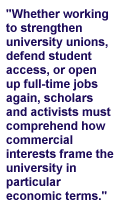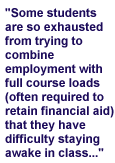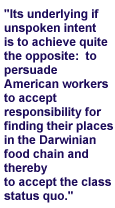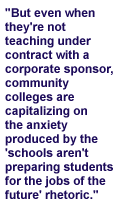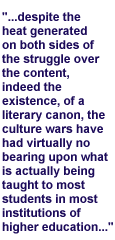Public Higher Education At The Turn Of The Century
|
"I have something to say to every family listening tonight. Your children can go on to college. . .We can make college as universal in the 21st century as high school is today." THE FISCAL CRISIS CONSENSUS 1. To many of us, the contemporary discourse on education appears to be contradictory. On the one hand, in rhetoric that has become familiar to the point of cliché, we are told that higher education is the key to the nation's (and the individual's) success in today's "highskillshighwageeconomy" (Economist, August 22, 1992, p.21). As in the past more education is being presented as the solution to pressing social and economic problems in the U.S.. Most recently, the RAND Institute's 1997 Report, The Fiscal Crisis of Higher Education, [1] prescribed this remedy for the widening disparities in earnings among Americans:
3. The so-called fiscal crisis of higher education is largely a consequence of people taking both messages seriously. Scholars and activists who wish to preserve--if not improve--public higher education must understand the fallacies of both messages and of the relationship between them. To strategize against the corporate-like restructuring of education and to develop arguments in favor of a meaningful curriculum and of acceptable working conditions for university employees, it's necessary to recognize how RAND and its allies exploit both the promise of education and an attack on the university's "liberalism" to push a conservative, corporate agenda. That means becoming conversant with the economic justifications RAND and others offer, and with the limitations--if not downright disingenuousness--of those justifications. Whether working to strengthen university unions, defend student access, or open up full-time jobs again, scholars and activists must comprehend how commercial interests frame the university in particular economic terms. These interests are not actually describing a mainstream consensus on higher education, they are manufacturing one. University activism cannot hope to succeed unless it can intervene in this rhetorical and ideological campaign. This paper aims to explain how that economic frame is constructed around the university, and how the naturalized language of market forces is used both to encourage more people than ever to seek salvation in a university degree while also encouraging them to disparage the dearest principles of liberal arts education. 4. As Americans flock to colleges and universities in record numbers--bolstered by demographic shifts that are expected to increase the college age population by twenty percent in the next decade (Passell, 1997)--this influx is increasing the financial pressures on these institutions at the same time that the public purse strings supporting them have been pulled tighter and tighter. Stagnating revenues tell only part of the story of the fiscal crisis, of course. A further factor is that higher education's costs have been escalating--increasing more rapidly than the consumer price index, the most widely used measure of the overall rate of inflation. 5. The effects of rising costs and stagnating revenues are evident to anyone involved in public higher education. The City University of New York, where I teach, is the largest urban university in the U.S. At one time city and state funds covered 80% of the annual budget. They now provide less than 56%.[2] Tuition for our students (over half of whom come from families with taxable incomes under $20,000), once free, is steadily rising but comes nowhere near to being adequate to make up for the drop in government funds. As at other public colleges and universities, the consequences include reduced course offerings and packed classrooms, fewer counselors and librarians, dramatically increased ratios of part-time faculty to full-time faculty, heavier teaching loads along with less time to do non-sponsored research, more pressure to raise outside funding, and disappearing support services and intellectual resources (such as research, teaching, grading and secretarial assistance, photo-copying exams and papers, travel money for conferences, the use of express mail, library subscriptions for essential journals, other publications and data bases, and fully-paid sabbaticals). Some students are so exhausted from trying to combine employment with full course loads (often required to retain financial aid) that they have difficulty staying awake in class, not to mention finding the time they need to keep up with reading, prepare assignments, or participate in the sorts of on-campus activities that enrich educational life. 6. There is an emerging mainstream consensus--exemplified by the RAND Report--on who is responsible for this fiscal crisis and what should be done about it. RAND places responsibility for the fiscal crisis on the federal government (for favoring entitlements, such as Social Security and Medicaid, and interest on the national debt, over education) on state and local governments (for spending more on health and welfare programs and corrections, mainly prisons, than on higher education) and on educational institutions themselves (for allowing their costs to grow more rapidly than inflation). But while acknowledging that government and higher education each bear some responsibility for creating the crisis RAND reflects the mainstream consensus in arguing that educational institutions must act first if the crisis is to be resolved:[3]
7.What specifically must higher education do to garner legislative and business support? According to RAND, it must dismantle existing governance structures, pursue greater mission differentiation (with sharp distinctions among community colleges, state university colleges, independent colleges, and research universities), take advantage of Internet-based technology to share resources and pool courses and instructors, jointly outsource services, combine physical plants, and place library resources on the Internet. RAND even proposes eliminating "the traditional sharp distinction between the bachelor's degree and all other nondegree categories" in favor of "the attainment of more specific, measurable knowledge sets. . ." (RAND, 1997, pp.23- 30) (For a more detailed summary of these recommendations see the Appendix) These measures, if adopted by public colleges and universities (as many of them already have been to some degree[5]) will profoundly affect faculty, staff and students and the nature of research and curricula. Indeed, the basic values, practices, mission and ethos of higher education are at stake. Just as the budget deficits of the Reagan and Bush years provided the motivation for cutting back on a range of federal, state and local government services, and the techniques of business downsizing provided the means, so too are fiscal deficits and management means[6] combining to restructure public higher education today. 8. This consensus has not gone unchallenged. David Noble, for example, places the blame for the fiscal crisis on the "wholesale reallocation of university resources toward its research function at the expense of their educational function" that began in the mid-1970s. (Noble, 1998, p.41) Moreover, he points out that the primary beneficiaries of today's rush to implement technological solutions to the crisis will not be the students but the "vendors of the network hardware, software, and 'content'. . . who view education as a market for their wares. . . [and] corporate training advocates" who "envision the transformation of the delivery of higher education as a means of supplying their properly-prepared personnel at public expense." Indeed, rather than mitigating the fiscal crisis, Noble argues that these "high-tech remedies are bound only to compound the problem, increasing further rather than decreasing the costs of higher education." (Noble, l998, pp.42-43) 9. But whatever the causes of the fiscal crisis, the shortfall of revenues relative to costs has led to sharply rising tuition in a period when most family's incomes have stagnated or fallen. This combination of fiscal crisis and income constraints, RAND warns, is "a time bomb ticking under the nation's social and economic foundation." (RAND, 1997, p.3) It threatens to close off access to higher education for millions of Americans, their only solution to the growing income gap and the social disorder it threatens. 10. For RAND, and like-minded education reformers, only by dramatically restructuring higher education can this time bomb be defused. But, in fact, rather than disabling the time bomb, their proposals will serve to enable the processes of class stratification to safely proceed. Not only will more schooling (increasingly and tellingly being referred to as post-secondary education), on its own, fail as a solution to widening income disparities, the proposed pathway to its achievement, the restructuring of higher education, will actually reinforce inequality. Through so-called mission-differentiation the restructuring will both further advance the class stratification of higher education and rationalize and economize on the processes whereby workers are sorted into their "appropriate" places in the educational and employment hierarchies. The restructuring, if realized, will also remove the primary obstacles to achieving this agenda-- faculty governance and tenure and an informed, critically thinking and politically engaged student body. Thus the rhetoric of more education is not only false in its promise to close the income gap. Its underlying if unspoken intent is to achieve quite the opposite: to persuade American workers to accept personal responsibility for finding their places in the Darwinian food chain and thereby to accept the class status quo. By commodifying and instrumentalizing education, by effectively limiting access to the liberal arts to the privileged (after the so-called culture wars have convinced everyone else of their irrelevance), the restructuring of higher education is both solidifying class polarities and attempting to attenuate the threats they pose to the social order. 11. Also lurking behind both the restructuring formulas being proposed by RAND and other mainstream reformers of higher education, and the seductive language and practices of the marketplace that provide both their guiding ethos and instruments of implementation, are strategies for opening up the campus as a site for capital accumulation and as a hot house for nurturing consumers. Although a discussion of these phenomena is beyond the scope of this essay, they are sufficiently important at least to note. They include establishing for-profit degree granting institutions (such as the University of Phoenix); outsourcing curriculum, instruction, counseling, operations and administration (in such areas as bookstores, food services, libraries, computer operations, plant maintenance, security, printing and payroll); signing campus- corporate research and development partnerships and licensing agreements; and selling exclusive on-campus marketing rights to companies that sell products as varied as soft drinks, fast food, computers and credit and telephone calling cards.[7] The campus is becoming virtually indistinguishable from the marketplace and both universities and their faculties are becoming entrepreneurs. FALSE PROMISES: CLOSING THE INCOME GAP 12. That wage inequality has been increasing over the past two decades is by now so well established that it is virtually a "platitude of wage economics."(Bernstein and Mishel, 1997) So, too, is the fact that for middle- and low-wage workers real wages have, at best, stagnated and for many have actually eroded.[8] Also widely documented is the correlation between income and education and a rising "college wage premium":
Many politicians and economists have been quick to put the high skills economy spin on this data concluding that the "demand for higher-skilled workers must have increased in recent decades" even more rapidly than the supply (Carnevale and Rose,1998, p.18) and attributing this increase in demand to a surge in service-related jobs that "require a level of knowledge and skill that, for the most part can be gained only through programs offered at colleges and universities." (RAND, l997, pp.6-7) These conclusions echo an earlier op-ed in The New York Times (July 20, 1993) by then Labor Secretary Robert Reich explaining that:
The dilemma, Reich continues, is that employers in the U.S. and Britain have responded directly to "changes in labor force supply and demand. The result has been greater inequality in wages and working conditions." His solution? Domestic policies "to deal with the mismatch between the skills Americans have and the skills the economy requires." In a word, more education. 13. Thus it is not surprising to find that increasing numbers of Americans are choosing to stay in school longer: "American workers have more years of formal education than ever before. . . more students are finishing high school. . . more high school graduates are attending college. . . the share of the labor force with a college degree has also increased, from 16 percent in 1973 to 29 percent in 1993." (Council of Economic Advisers and the U.S. Department of Labor, 1998) According to the Bureau of Labor Statistics "an all time high" of 65 percent of 1996 high school graduates were attending colleges or universities by the fall. What is surprising is that despite this two-decades long increase in education levels--accompanied by plummeting unemployment and continuing (if now slowing) economic growth--wage inequality continues to grow. Indeed, as "workers at the top of the wage scale have pulled away from both those in the middle and those at the bottom" the upward differentials have increased and the downward differentials have decreased for those very workers--the 50 to 60 percent in the middle of the earnings range--who most likely rushed to upgrade their educational achievement from high school degree to some post-secondary education and training if not beyond (Bernstein and Mishel, 1997; Mishel, Bernstein and Schmit, 1998) Moreover the much heralded college wage premium[9]--which was said by some economists to account for a large part of the growth in income inequality in the l980s--has "been flat for men and has slowed for women in the l990s," while income inequality continues to widen. (Bernstein and Mishel, l997, p.12) 14. Indeed, it seems that rather than the mismatch that Reich bemoans, there may actually be an excess rather than a shortage of college graduates. (Assuming, of course, that one accepts the mercenary calculus that values education only in terms of how much the degree is worth in the labor market.) Last year, Business Week (October 6, 1997) reported a Labor Department projection that the growing supply of college grads could outstrip growth in demand by as much as 330,000 annually by 2005. According to Department of Labor economists the percentage of college graduates who are employed in jobs that don't require a college degree grew from just over 10 percent in 1970 to 20 percent in 1990 and, if current job and education trends continue, may be as high as 30 percent for college graduates who enter the work force from 1990 to 2005. In its 1998-1999 Occupational Outlook Handbook, the Bureau of Labor Statistics projects that 26.48% of the net new jobs that will be created through 2006--in the 30 occupations expected to grow fastest and the 30 occupations expected to provide the highest number of jobs--will require a bachelor's degree or higher. Another 7.55% will require an Associate's degree or other post- secondary vocational training. The balance, 65.97%, will require short-term on-the-job training (51.23%), moderate-term on-the-job-training (5.37%), long-term on-the-job training (2.66%) or work experience in a related occupation (2.66%).[10] 15. But if the already higher level of post-secondary education seems to be having no discernible impact on income inequality, why do so many public figures--who surely have access to the data referred to above--persist in claiming otherwise? One possibility is that they don't know what else to propose, since such obvious strategies as further increasing the minimum wage and easing rules that favor bosses in union organizing efforts and/or labor conflicts (e.g., those that allow the hiring of permanent replacements during strikes or prohibit secondary boycotts) are all politically beyond the pale. Another is that the prescription has the ring of truth to it. While upgrading the average level of post-secondary schooling may not alter the overall distribution of earnings, for an individual further schooling offers a plausible-sounding, even somewhat effective strategy, for at least, perhaps, improving one's place on the earnings ladder. Such a strategy, moreover, is also consistent with the long-standing American ideology of individuality (or in today's terms, personal responsibility). Additional education, particularly of the vocationally oriented post-secondary variety envisioned by mainstream education reformers, also offers clear advantages to employers. The more education or training that an employee brings to the job, the less on-the-job training is required, particularly if the training is relatively job specific. (Recall RAND's final recommendation regarding "specific, measurable knowledge sets.") 16. Thus, a Business Week headline shouts,"Your Local Campus: Training Ground Zero." And the story continues, "These days community colleges are awash in corporate contracts...Local governments see the programs as engines for business development. Employers, meanwhile, have discovered that the colleges are better at most sorts of training--and cheaper too." But even when they're not teaching under contract with a corporate sponsor, community colleges are capitalizing on the anxiety produced by the "schools aren't preparing students for the jobs of the future" rhetoric. According to Stanley Aronowitz, 77 percent of today's degrees from community colleges are terminal degrees; 23 percent of their graduates go on to four-year colleges. This ratio, he says, "is a virtual reversal of what the proportions were ten years ago."[11] These anxious students, from recent high school graduates to adults (many of them victims of corporate downsizing), have caused enrollments at community colleges to soar. For the employers of the vast majority of the work force needing on the job training, these programs-- some of which are degree-granting, others offered through adult extension courses--are a way to externalize what were previously the internal costs of job-specific training and screening prospective employees. Employers, writes Business Week (September 1, 1997) can find plenty of eager applicants to fill well-paying jobs that do not require a college degree ("a category that, surprisingly, covers three-quarters of all jobs"); the only problem is, "employers usually must train them." But why should corporations internalize training costs on-the-job if they can impose them on public post-secondary education and their prospective employees? 17. Like their community college cousins, business schools are increasingly forming what are arguably "uneasy alliances" with companies and their corporate universities to develop and deliver "customized programs tailored to the needs of individual companies." (Mangan, l998) Just how uneasy these alliances may be is captured by the following comment from a Ford executive who has worked with five universities to develop a "Ford curriculum for the next century." He tells these universities, he says:
18. Such reasoning comes from within academic administrations too. I recently received the following communication from a colleague at the University of Wisconsin's Milwaukee campus. Her Dean, she writes:
19. But at the same time that the restructuring of higher education is erasing the boundaries that divide the campus from the market nexus, other boundaries, those between institutions and between classes, are being firmed up. FIRMING UP INTERINSTITUTIONAL AND CLASS BOUNDARIES 20. The prototype for interinstitutional differentiation is the University of California's Master Plan for Higher Education, developed in 1959 and 1960 under the guidance of then-UCAL President Clark Kerr. (Kerr, 1994, pp.66-67) Facing a wave of post-war baby boomers and immigrants, then largely from other states, Kerr feared that without mass- and universal-access higher education[12] "the University was going to be either overwhelmed by large numbers of students with lower academic attainments or attacked as trying to hold onto a monopoly over entry into higher status." The Master Plan was designed to preserve the elite sector, indeed to "make it possible for the elite sector to become more elite."[13] The idea was to create a system of higher education that would both "help identify new talent for transfer into the elite sector" and "create a base for social gradations in a democracy that reduce the sharp distinctions (and potential resentments) between the educated classes and the uneducated masses, and that help to soften class distinctions and class antagonisms." Under the Master Plan, the different segments of the system (the University of California, the state colleges and the community colleges) were each assigned differentiated functions, admissions criteria and research goals. The university system would admit the top 12.5% of high school graduates, be the primary state-supported academic research agency, and would emphasize graduate and professional programs with exclusive jurisdiction over law and graduate instruction in medicine, dentistry and veterinary medicine and the awarding of Ph.D. degrees (although it could agree to do so jointly with state colleges). The state colleges would admit the top 33% of high school graduates, have as their primary function undergraduate instruction and graduate instruction through the master's degree and focus on applied research. The community colleges, located throughout the state to ensure that every high school graduate would be within commuting distance, would admit any high school graduate and offer "vocational and technical instruction, and general or liberal arts courses" up to but not beyond the fourteenth grade level. (Kerr, 1994, pp.111-126) 21. Over the ensuing decades, however, the clear institutional demarcation envisioned in the California Master Plan began to erode, and not only in California. According to RAND, community colleges attempted to become four-year degree-granting institutions, state universities to become research centers, and research universities to offer remedial instruction. (RAND, 1997, p.26) The RAND Report proposes to roll back this so-called "mission creep": "If higher education institutions and systems focus on their points of comparative advantage within the overall ecology of higher education, both productivity and improved quality will result." (RAND, 1997, p.26) The class-stratifying implications of RAND's specific recommendations for achieving greater mission differentiation become evident when they are juxtaposed against Kerr's proposals for "A Twenty-First Century Convergence Model of Higher Education" in which each level of interinstitutional differentiation corresponds to one of three levels of training, each of which is associated with a different type of work, labor market and basis for student access (Kerr, 1994, pp.89-90). The liberal arts are strikingly absent from this framework for public higher education. Indeed, according to the RAND Report, it is the independent college sector that "should focus on its comparative advantage: the liberal arts undergraduate mission." AFFORDING PUBLIC HIGHER EDUCATION IN THE TWENTY-FIRST CENTURY 22. Tuition increases at both private and public institutions are also changing the class profiles of many of these institutions, reinforcing divisions already being made sharper by the growing income gap and stagnating incomes discussed above, by cuts in federal and state financial aid, and by the recent retreat from affirmative action. In what Russell Jacoby (1994, p.21) terms both the gentrification and restratification of higher education, the proportion of students from more affluent families sending their children to public universities has been rising sharply. And the public universities they've been choosing are the flagship institutions: the University of Michigan at Ann Arbor, the University of Texas at Austin, the University of California at Berkeley, and so on. Because college entrance exam scores are highly correlated with income, these more affluent students are squeezing out the "'middle' middle class, once the backbone of these universities." Writing before the affirmative action backlash, Russell Jacoby notes:
Some of the students squeezed out of the elite public campuses are finding their way to second- tier public institutions, such as the California State system, which are experiencing a parallel "richening" of their student bodies.[14] The downward cascade continues through the community colleges, as Morton Shapiro points out:[15] "The poor are increasingly restricted to community colleges, even being squeezed out of four-year public institutions." 23. The ways private colleges have responded to these shifts in enrollments have further exacerbated the restratification process. Although Princeton, Yale, Stanford, and MIT have announced plans to increase financial aid to low- and middle-income students (with the primary beneficiaries being students whose parents own their own homes and/or have other savings), less well endowed institutions are abandoning "need-blind" admissions and increasing so-called merit aid. (Bronner, 1998; Gose, 1998a, 1998b) As a result, "Students from lower-income groups, including members of minorities, who are not at the top of their classes may be rejected because of their inability to afford the tuition, while students of similar qualification but higher income will get in."[16] THE FISCAL CRISIS AND THE CULTURE WARS 24. Although in this essay I've been primarily concerned with the role of the fiscal crisis in the restructuring of public higher education, I want to focus briefly on the part played in the process by the culture wars. On the one hand, despite the heat generated on both sides of the struggle over the content, indeed the existence, of a literary canon, the culture wars have had virtually no bearing upon what is actually being taught to most students in most institutions of higher education: "The curriculum of students at elite colleges"--the target of the culture wars' critics--"is so different from that followed by the other 97% that it is irrelevant to discussions."[17] (Jacoby, 1994, p.14) On the other hand, what the culture wars did accomplish was to distract many left intellectuals while it further devalued the liberal arts in the minds of the great majority of students (and their families) who are destined to occupy places in vocationally focused post- secondary education. As the former President of the for-profit University of Phoenix (William Gibbs, previously a manager with Price Waterhouse) put it: "The people who are our students don't want an education. They want what the education provides for them--better jobs, moving up in their careers, the ability to speak up in meetings. That kind of stuff." (Traub, l997, p.114) 25. So it should come as no surprise that the future of the liberal arts has gone virtually unmentioned in the entire discussion of the fate of public higher education. Indeed, pushed along by two decades of budgetary and ideological assault (the culture wars), today's restructuring represents but the final stages of a redesign that will preclude the liberal arts--with their possibilities for cultural enrichment and informed, critical engagement in public life--as a viable course of study for the vast majority of Americans. Twenty-three years ago, the conveners of a Trilateral Commission meeting in Kyoto, Japan, formulated the question of "what for, a college education?" in terms of the following alternatives:
As we look at the state of public higher education today--the increasing class stratification and vocationalization, the virtual termination of access for the vast majority to the liberal arts in any but the most superficial senses,[18] the intellectual and material hegemony of free market economics and the folklore of capitalism--we see that the answer to the Trilateral Commission's noble question has been a resounding negative. 26. The restructuring of higher education is not only solidifying the class status quo and opening up public higher education to the forces of commodification, proletarianization and capital accumulation, it is depriving the American polity of the sort of critically thinking, politically engaged citizenry essential for truly participatory democracy. And democratic structures, in the absence of educated, involved citizens are, at best, likely to end up dominated by more or less tightly coupled oligarchies and/or by demagogues. Marilyn Kleinberg Neimark, Baruch College, CUNY |
by Marilyn Kleinberg Neimark
|
